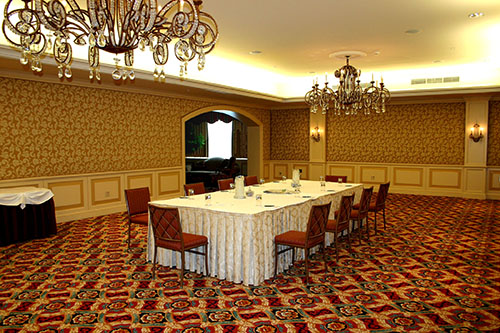
(I could not remember the name of this conference room in the South Building of the resort to save my life until I got serious this morning).
I am blinking at the breakfast table. I appear to be in Arlington again and I am not sure exactly why. The radio tells me there is wreckage washing up on Australia’s west coast. Parts of MH-370? I need to drag myself back into the real world. The Broadmoor was much nicer. I could become accustomed to that lifestyle. Prices were right- it is still the off season, and I basked in the luxury of their very cheapest room.
The staff was unfailingly solicitous and courteous- it made me wonder about how they create an artificial world that owes much allegiance to the world of 1918 when the venerable Western hotel first opened. People do not act with such decorum in the larger society any more. It was quite remarkable, and I followed an orientation group of new employees as they were introduced to the fitness center near the entrance to the resort golf course.
Wandering along the trail around the large artificial lake I noted the wry humor of the place- positively western. The signage on the grounds is remarkable: “BROADMOOR” is spelled like that, apparently because one of the early incarnations of the hotel logo had been printed by someone who thought that the word “brod” did not contain an “a” and one had to be added in the available space afterward.
The art in the buildings is quite remarkable. In fact, beyond remarkable. I was in the Broadmoor South Building. On the Mezzanine Level are three meeting centers and a Board Room off the corridor from the grand public lobby where the flagstone fireplace burns merrily, as it has since the building was first constructed.
One is devoted to one of my favorite artists, western or not: Frederick Remington.
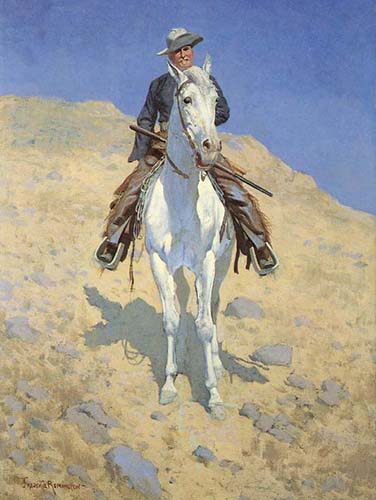
(Frederick Remington: Self Portrait on horse.)
Adjacent to the Remington Room is one devoted to a fellow I had never heard of: Charles Schreyvogel.
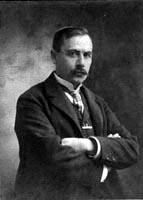
(Charles Schreyvogel, January 4, 1861-January 27, 1912)
The Art of the West can be a little over the top to modern sensibilities. Remington’s work included the element of humor as an essential component of larger-than-life personalities in a wider-than-the-imagination landscape. His animals- horses, bison and the like- are extraordinary. He was not the only one to exploit the mythic aspects of the Conquest of the West. I am not sure that narrative would fly today- I mean, it all happened, though perhaps not quite the way it is depicted in the heroic canvases.
But the hell with it. I liked that old narrative better than the one they are peddling today.
It is more than a little ironic that the two galleries are next to one another. Schreyvogel was represented by perhaps five very large paintings. His approach was to capture the moments of collision between Native American and settler, but more particularly the cavalry troopers.
The first painting I saw literally took my breath away. In it, a bold trooper shields a young blonde girl as he rides away from half-naked savages:
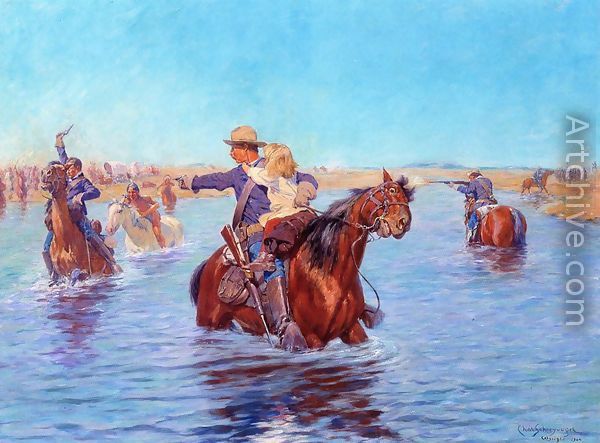
You can feel Director John Ford channeling his inner Schreyvogel in his great film “the Serachers.”
These are larger-than-life works- heroic enough in size to dominate a salon of the Gilded Age of which Schreyvogel was part. They say that he was book-eneded by Remington, who died a couple years before him, and Russell, who came after. Although his gallery is displayed in the room adjacent to that devoted to Remington’s work, the two were involved in a bitter dispute over the historical veracity of his painting “Custer’s Demand.”
No one would be doing work like this anymore, and in fact, given the subject of the body of his work (mostly done in his rooftop studio in Hoboken, NJ, though with frequent research trips to places like the Ute Reservation just overt the mountains to the west).
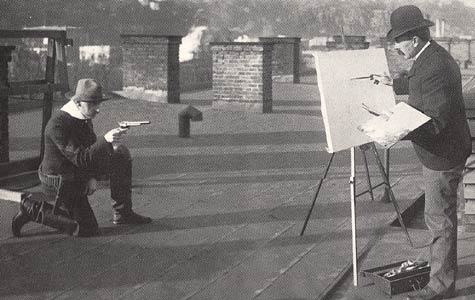
I am surprised no one has taken offense at the blatantly martial and blatantly racial component of the paintings. Around the room were images of bold troopers silencing the Indians. The “Silenced War Whoop” is an exemplar of the style:
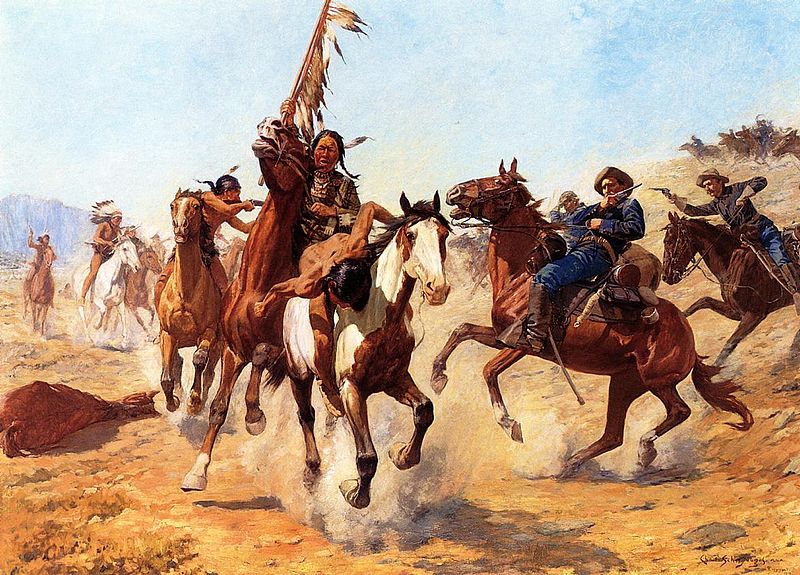
(The Silenced War Whoop, Schreyvogel, 1904. On the north wall of the conference room).
There were three more images in the room- originals, I surmise, most of them painted in Schreyvogel’s most prolific period just after the turn of the 20th Century. I could not for the life of me remember his name, after having completely forgotten to do what I normally do in these days of failing short-term memory: take a picture with my smart phone.
I was wracking my brain. A German name, I thought. Starting with a consonant?
I finally went to the Broadmoor site and looked at conference room names and found him. Schreyvogel! Of course! From a family with a lot in common with mine- both families fled Prussia in the 1840s to get away from Militarism, only for the young Charles to become enraptured with the Buffalo Bill Cody Wild West Show.
Wild Bill befriended him, and the legend inspired more legends.
Schreyvogel only sold about a hundred paintings in his short life- blood poisoning nailed him at the age of 48 in 1912. In his prime, he was despised by Remington over the 1904 painting: “Custer’s Demand:
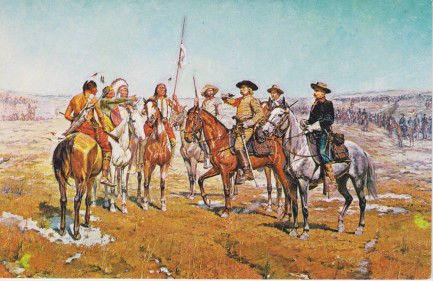
Remington claimed there were numerous material errors of fact in the painting- which he very publicly trumpeted. For his part, Schrevogel produced documentation from Custer’s daughter and the only surviving officer who had actually been at the meeting to vindicate the veracity of his image. I don’t think that is the New Jersey Palisades in the background, but you never can tell.
Artists!
But I am gratified that I was able to figure it out. Some of the original Schreyvogel paintings have gone for more than a million at auction, including one that was in the estate of Marge Schott. She was reviled as “insensitive” and worse in her time owning the Cincinnati Reds. Oh well. I don’t claim to understand great art, but I do know it when I see it. Coulld those have been the originals on the wall of that conference room at the Broadmoor?
Amazing. And what would Remington have said that Schreyvogel was closest to the entrance?
Copyright 2014 Vic Socotra
www.vicsocotra.com
Twitter: @jayare303
